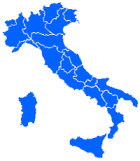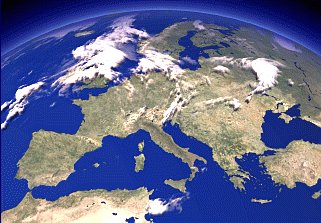|
Italy's Profile
|

|
 |
Area: 116,303 square miles
Population: 56,778,000
Population density: 487/sq. mile
Capital: Roma (2,775,000 inhabitants)
Other important cities:
|
|
Milano (1,369,000) |
Firenze (403,000) |
Messina (231,000) |
|
Napoli (1,067,000) |
Bari (342,000) |
Trieste (231,000) |
|
Torino (963,000) |
Catania (333,000) |
Padova (215,000) |
|
Palermo (699,000) |
Venezia (309,000) |
Cagliari
(204,000) |
|
Genova (679,000) |
Verona (256,000) |
Brescia (195,000) |
|
Bologna (404,000) |
Taranto (232,000) |
Perugia (153,000) |
 |
Situated in Mediterranean Europe, Italy has
land frontiers with France in the north-west,
Switzerland and Austria in the north and Slovenia
in the north-east. The peninsula is surrounded
by the Ligurian Sea, the Sardinian Sea and the
Tyrrhenian Sea in the west, the Sicilian Sea
and the Ionian Sea in the south and the Adriatic
Sea in the east. Italian is the language of
the majority of the population but there are
minorities speaking German, French, Slovene
and Ladino.
|
|
Geographical Profile
There is a great deal of variety in the landscape
in Italy, although it is characterized predominantly
by two mountain chains: the Alps and the Apennines.
The former extends over 600 miles from east
to west. It consists of great massifs in the
western sector, with peaks rising to over 14,000
feet, including Monte Bianco (Mont Blanc), Monte
Rosa and Cervino (the Matterhorn). The the chain
is lower in the eastern sector, although the
mountains, the Dolomites, are still of extraordinary
beauty.
At the foot of the Alpine arc stretches the
vast Po Valley plain, cut down the middle by
the course of the river Po, the longest in Italy
(390 miles), which has its source in the Pian
de Re (Monviso) and flows into the Adriatic
through a magnificent delta. The Alpine foothills
are characterized by large lakes: Lake Maggiore
and the lakes of Como, Iseo and Garda. The Apennines
form the backbone of the peninsula, stretching
in a wide arc concave to the Tyrrhenian Sea.
The Corno Grande (Gran Sasso d'Italia) is the
highest peak. A large part of central Italy
is characterized by a green hilly landscape,
through which the rivers Arno and Tevere (Tiber)
run. The southern section of the chain pushes
out to the east forming the Gargano promontory
and, sloping down further south, the Salentine
peninsula. It then proceeds to the west with
the Calabrian and Peloritano massif stretching
across the Strait of Messina into Sicilia. The
principal islands are Sicilia, rising up to
the great volcanic cone of Etna (10,860 feet)
and Sardegna. The main archipelagos are the
Tremiti Islands in the Adriatic Sea, the Tuscan
Archipelago, the Pontine Islands, the Aeolian
Islands and the Egadi Islands in the Tyrrhenian
Sea off the coast of Sicilia.
|
|
|
|